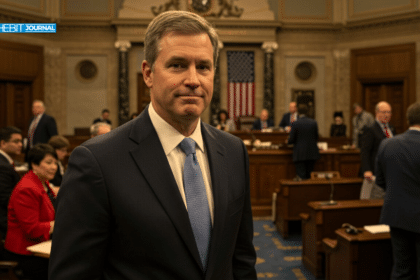Michael Saylor, Executive Chairman of Strategy Inc. (formerly MicroStrategy), has stirred controversy by publicly rejecting the concept of on-chain Proof-of-Reserves (PoR), a move that reignites the debate between corporate transparency and asset security in the crypto space.
Speaking at the Bitcoin 2025 conference in Las Vegas, Saylor made it clear that while Bitcoin is trustless, institutional holders don’t owe the public full visibility into their crypto wallets. His comments come as Strategy Inc. holds over 580,000 BTC, worth around $60 billion, making it the largest corporate Bitcoin holder in the world.
Saylor’s Take: Proof-of-Reserves is “a Bad Idea”
During the event, Saylor explained his skepticism toward PoR in no uncertain terms:
“Go to AI, put it in deep think mode and ask it what the security problems are of publishing wallet addresses, it’ll write 50 pages.”
He likened publishing wallet addresses to “handing out the bank accounts of all your children.” His primary concern? Making Bitcoin holdings publicly traceable introduces a major attack vector, both from cybercriminals and financial adversaries.
Saylor argues that Proof-of-Reserves not only fails to show liabilities, one of the critical pillars of financial solvency, but also exposes firms to AI-powered targeting and blockchain surveillance that could jeopardize treasury integrity.

What is Proof-of-Reserves, and Why Does It Matter?
Proof-of-Reserves is a system where centralized crypto platforms or custodians cryptographically verify that they hold enough assets to cover user balances. Typically done using Merkle trees and cryptographic hashes, PoR gained prominence after the collapse of FTX in 2022, as users demanded verifiable assurance that platforms weren’t over-leveraged.
Exchanges like Binance, Kraken, and OKX have embraced PoR reports to restore market trust. However, these reports often lack details about liabilities and off-chain debts, making them incomplete indicators of solvency.
Saylor argues that the system is unnecessary and risky for public companies like Strategy Inc. He prefers traditional auditing and SEC-regulated reporting as the appropriate transparency framework.
Community Backlash: Transparency or Red Flag?
Saylor’s hard stance triggered strong reactions from the crypto community. On Reddit and X, many users criticized him for taking a step away from the transparency ethos of Web3.
One user wrote:
“If PoR compromises security, then why do leading exchanges still do it? Either Saylor doesn’t understand crypto, or he’s hiding something.”
Some analysts agree, suggesting that Saylor’s aversion to public on-chain proof may appear opaque to retail investors who prefer open verification over institutional auditing processes.
Meanwhile, Kraken co-founder Jesse Powell emphasized that real PoR requires a clear view of both assets and liabilities, not just wallet snapshots. Anything less, he says, offers “false comfort.”
AI and the New Threat Model
While many dismiss Saylor’s AI argument as exaggerated, it touches on a growing concern in crypto: AI-enhanced blockchain analysis. Public wallet disclosures—especially at the corporate level—can now be mined, clustered, and exploited by sophisticated adversaries. Whether targeting corporate security, exploiting DeFi protocols, or mapping transaction flows, AI-driven tracking is no longer fiction.
Saylor’s point? As wallets become publicly linked to entities holding billions in BTC, the threat model expands exponentially.

Strategy Inc.’s Position: SEC Compliance Over On-Chain Proof
Saylor contends that his firm, being publicly traded, is already held to rigorous financial disclosures. Strategy Inc. reports its Bitcoin holdings in quarterly filings with the U.S. Securities and Exchange Commission (SEC), and is regularly audited.
“We already disclose more than enough through our financials. PoR isn’t built for institutional-scale security.”
His approach places trust in the traditional regulatory system, whereas many in the crypto space favor on-chain, code-based trust mechanisms.
Trust, Security, and the Institutional Future of Bitcoin
Saylor’s remarks underscore a growing tension: as institutional investors increase their exposure to crypto, how can they balance transparency with operational security?
Exchanges want public trust and therefore adopt PoR.
Institutions prioritize internal controls, compliance, and discretion.
Retail investors want visible, verifiable proof of ownership.
This disconnect may shape how institutional capital flows into Bitcoin in the coming years. For some, Saylor’s stance is strategic. For others, it’s a regression from the open principles crypto was built on.
Conclusion
Michael Saylor’s rejection of Proof-of-Reserves adds a bold twist to the transparency versus security debate. While he may have valid concerns around exposing wallet addresses and opening the door to AI-driven threats, his stance puts Strategy Inc. at odds with a rising demand for open verification in crypto finance.
As the crypto world continues to mature, institutions like Strategy Inc. will face increasing pressure to justify their trust models—whether it’s through SEC filings, public blockchains, or both.
FAQs
What is Proof-of-Reserves (PoR)?
A method for crypto platforms to prove they hold enough assets to back user balances, usually via public wallet disclosures and cryptographic proofs.
Why did Michael Saylor reject PoR?
He believes PoR creates security risks by exposing wallet addresses and does not account for liabilities.
How does Strategy Inc. disclose its Bitcoin holdings?
Through SEC filings and audited financial reports, not through public wallet addresses.
Glossary of Key Terms
Proof-of-Reserves (PoR): A method used to verify that an institution holds enough crypto assets to cover user deposits.
SEC Filings: Mandatory financial disclosures submitted to the U.S. Securities and Exchange Commission by public companies.
Custodial Wallet: A crypto wallet managed by a third party, often used in institutional holdings.
Liabilities: Financial obligations or debts, which PoR reports often fail to disclose.
AI-driven Analysis: The use of artificial intelligence to track, trace, or exploit blockchain activity.





























